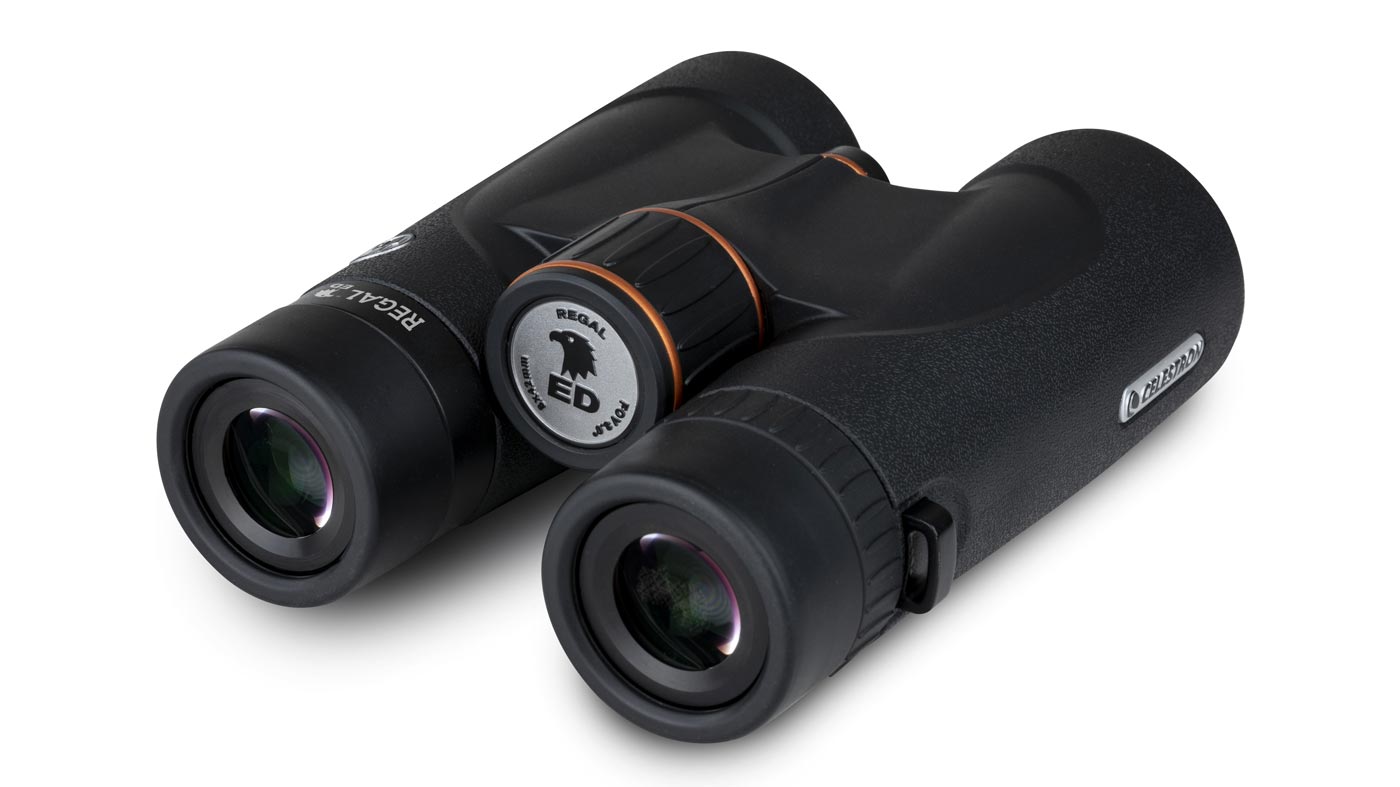Celestron Regal ED Flat Field 8x42 binocular
It's been a year since we last saw a new Celestron binocular and the American optics company has just launched a new premier line. The Regal ED Flat Field 42 mm objective binoculars, which are available with 8x or 10x magnification, are designed with the most selective of binocular users in mind: birders.
I opted to test the 8x42. Feeling seriously solid, this new model exudes robustness from the word go. Apart from a smooth area flanking the upper side of the hinge, the rubber body armour is what I would describe as 'medium textured' and it successfully increases the user's grip on the binocular. It is also contoured on the underside, just below the eyecups, where there are shallow cutaways or thumb-rests. These are positioned and shaped along the barrels rather than angled or across them, the latter tending to be the norm in the majority of models.

This got me thinking about how we actually hold and operate our binoculars. I'm right handed, using my index and middle fingers to turn the focusing wheel, while my thumb sits below and across the barrel, at approximately 90 degrees to its length. The thumb of my left hand occupies the same area on the other barrel, but is positioned quite differently, running along the barrel at approximately 20 degrees off the line along the length. The bottom line is that the cutaway on the Regal's left barrel offers a more comfortable grip than the one on the right. Pedantic, perhaps, but it's a design point worth considering.
One last point needs to be made on the armouring. It is thick and provides a broad, solid rim of protection around the objectives that is not easy to pull away, or peel back, from the lens housing, which can often be the case with many other manufacturers' models.
Ergonomically, the design mechanics are good and I was pleased to see the slightly recessed strap lugs positioned as close to the oculars as possible, in line only with the proximal edge of the focus wheel. This enabled the fore and middle fingers to be kept straight, maximising comfort for both focusing and holding.
The focus wheel is covered in rubber with wide, elliptical ribbing to improve grip while in use. Almost two anticlockwise rotations take the image between close focus and infinity, but only a quarter of a turn is required to focus between 10 m and more than 500 m.
The same elliptical ribbing is used on the single-eye focus. This is mounted on the right ocular and the dioptre setting is not lockable, although it remains static in its set position during use. There is an adjacent, simple '- 0 +' raised character scale, tiny and almost melded in with the textured armouring, while the setting pointer consists of the tiniest possible indentation on a slightly thinner rib on the wheel. If this combination was intended to be unobtrusive it was mission accomplished … and then some!
The eyecups are thinly wrapped in medium-hard rubber and they twist out smoothly to click-lock in two extended settings above the fully retracted base position. From my perspective, they were of average comfort against the eye. I was able to see the full field of view at the intermediate setting, but not when they were fully extended. Applying and removing the soft, flexible rainguard did not alter their positioning.
Moving on to the Regal's performance, with 140 m at 1,000 m, the nicely wide field of view was evident across a range of habitats, while the image was crisp and sharp to the edges. Moreover, the field-flattening lens system employed in this binocular virtually eliminates curvature of the field at its edges, and in this respect, I considered it to be on a par with recognised top-tier models.
The Regal also delivers a vibrant, contrasty image, which is strongly positioned at the 'warm' end of the colour rendition spectrum. To help increase image brightness, ED glass, combined with phase-coated Bak-4 prisms and fully multi-coated lenses, are employed in this binocular's optical configuration. Although ED glass goes some way to reducing chromatic aberration (CA), it comes in different grades, some more effective than others. There are, of course, viewing conditions which amplify CA, such as viewing dark birds against the light on bright, reflective water. In the Regal, CA is quite evident under such circumstances, but in general observation, across the board, it passes largely unnoticed.
Maintaining brand identity by sporting the same orange-bronze rings around the focus wheel and hinge as the Trailseeker ED, and the forward positioning on the left ocular of a boldly embossed 'REGAL ED', aesthetically, this binocular is very distinctive. It is supplied with a black woven cloth-covered, hard zip-up case, tethered but removable objective lens caps, articulated rainguard and, to enjoy the best of both worlds, a harness as well as a standard lanyard. At just £370, it's certainly very worthy of consideration for anyone on a budget.
Further info
- Price: £370
- Size: 152x130 mm
- Weight: 768 g
- Field of view: 140 m at 1,000 m
- Light transmission: 90%
- Close focus: 1.5 m
- Gas-filled: yes
- Waterproof: yes
- Guarantee: Limited lifetime warranty
Verdict
+ Image crisp and sharp to edge of field
+ Field-flattening lenses almost eliminate curvature
- Chromatic aberration evident when viewing dark birds against light background


